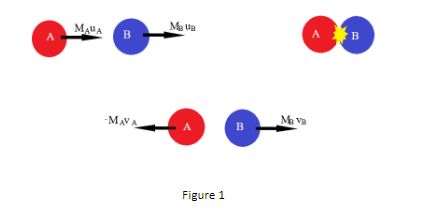
State the law of conservation of momentum and derive related expression.
Answer
517.8k+ views
Hint: In this first we start with the rate of change in momentum of body A and body B that is
Complete step-by-step answer:
According to the law of conservation of momentum when two bodies collide with one another, the sum of their linear momentum always remains unaffected; that is linear momentum after and linear momentum before the collision remains the same but this is true only when there is no external unbalanced force acting on the bodies.

Now let assume the following variables according to figure 1
The mass of body A equals
The mass of body B equals
The force exerted by body A on Body B equals
The force exerted by body B on Body A equals
The velocity of Body A before collision be
The velocity of Body B before collision be
The velocity of Body A after collision be
The velocity of Body B after collision be
Now we will find the change in momentum body A that is
Change in momentum = Momentum of body A after the collision – Momentum of body A before the collision
Now we will find the rate of change of momentum for body A that is equal to change in momentum of body A with respect to time
We know that the rate of change in momentum is same as force exerted by body B on body A that is
Similarly, the rate of change of momentum of body B will be equal to the force exerted by body B on body A that is
Now applying Newton’s third law of motion which is every action has an equal and opposite reaction, we can write
Here negative sign indicates that one of the body starts moving in the opposite direction after the collision
Now substituting equation (1) and equation (2) in equation (3) we will get
Now after rearranging we will get
Hence it is proved that the momentum after the collision is equal to the momentum before the collision if no external force is acting on the system.
Note: For these types of questions we need to have a clear understanding of all the three Newton’s laws of motion. We need to be clear with the concepts of forces, and momentum and how to calculate them. Since all these are vector quantities we need to be careful with the sign conventions.
Complete step-by-step answer:
According to the law of conservation of momentum when two bodies collide with one another, the sum of their linear momentum always remains unaffected; that is linear momentum after and linear momentum before the collision remains the same but this is true only when there is no external unbalanced force acting on the bodies.

Now let assume the following variables according to figure 1
The mass of body A equals
The mass of body B equals
The force exerted by body A on Body B equals
The force exerted by body B on Body A equals
The velocity of Body A before collision be
The velocity of Body B before collision be
The velocity of Body A after collision be
The velocity of Body B after collision be
Now we will find the change in momentum body A that is
Change in momentum = Momentum of body A after the collision – Momentum of body A before the collision
Now we will find the rate of change of momentum for body A that is equal to change in momentum of body A with respect to time
We know that the rate of change in momentum is same as force exerted by body B on body A that is
Similarly, the rate of change of momentum of body B will be equal to the force exerted by body B on body A that is
Now applying Newton’s third law of motion which is every action has an equal and opposite reaction, we can write
Here negative sign indicates that one of the body starts moving in the opposite direction after the collision
Now substituting equation (1) and equation (2) in equation (3) we will get
Now after rearranging we will get
Hence it is proved that the momentum after the collision is equal to the momentum before the collision if no external force is acting on the system.
Note: For these types of questions we need to have a clear understanding of all the three Newton’s laws of motion. We need to be clear with the concepts of forces, and momentum and how to calculate them. Since all these are vector quantities we need to be careful with the sign conventions.
Recently Updated Pages
Master Class 11 Economics: Engaging Questions & Answers for Success

Master Class 11 Business Studies: Engaging Questions & Answers for Success

Master Class 11 Accountancy: Engaging Questions & Answers for Success

Master Class 11 English: Engaging Questions & Answers for Success

Master Class 11 Computer Science: Engaging Questions & Answers for Success

Master Class 11 Maths: Engaging Questions & Answers for Success

Trending doubts
Which one is a true fish A Jellyfish B Starfish C Dogfish class 11 biology CBSE

State and prove Bernoullis theorem class 11 physics CBSE

1 ton equals to A 100 kg B 1000 kg C 10 kg D 10000 class 11 physics CBSE

In which part of the body the blood is purified oxygenation class 11 biology CBSE

One Metric ton is equal to kg A 10000 B 1000 C 100 class 11 physics CBSE

Difference Between Prokaryotic Cells and Eukaryotic Cells




